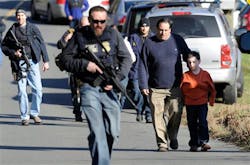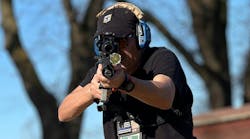The speed and deadliness of recent high-profile shootings have prompted police departments to recommend fleeing, hiding or fighting in the event of a mass attack, instead of remaining passive and waiting for help.
The shift represents a "sea change," said Chuck Wexler, executive director of the Police Executive Research Forum, which recently held a meeting in Washington to discuss shootings like those in Newtown, Conn., and Aurora, Colo.
The traditional advice to the public has been: "Don't get involved, call 911," Wexler said, adding that "there's a recognition in these 'active shooter' situations that there may be a need for citizens to act in a way that perhaps they haven't been trained for or equipped to deal with."
Wexler and others noted that the change echoes a transformation in police procedures that began after the shootings at Columbine High School in 1999, when some departments began telling officers who arrived first on a scene to act immediately rather than waiting for backup. Since then, the approach has become widespread, as several high-profile shootings across the country have made it clear that no city or town is immune and that police agencies must be prepared to take an active approach.
"We used to sit outside and set up a perimeter and wait for the SWAT team to get there," said Michael Dirden, an executive assistant chief of the Houston Police Department. "Now it's a recognition that time is of the essence, and those initial responders have to go in," he said, adding that since the Virginia Tech shootings in 2007, the department has been training first responders to move in on their own when they encounter active gunfire.
Research on mass shootings over the past decade has bolstered the idea that people at the scene of an attack have a better chance of survival if they take an active stance rather than waiting to be rescued by the police, who in many cases cannot get there fast enough to prevent the loss of life.
In 16 attacks studied by researchers, for example, civilians were able to stop the perpetrator, subduing him in 13 cases and shooting him in three cases. In other attacks, civilians have obstructed or delayed the gunman until the police arrived.
Copyright 2013 Virginian-Pilot Companies LLC. All Rights Reserved




